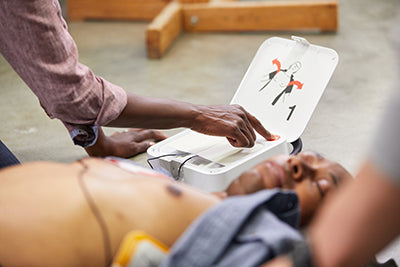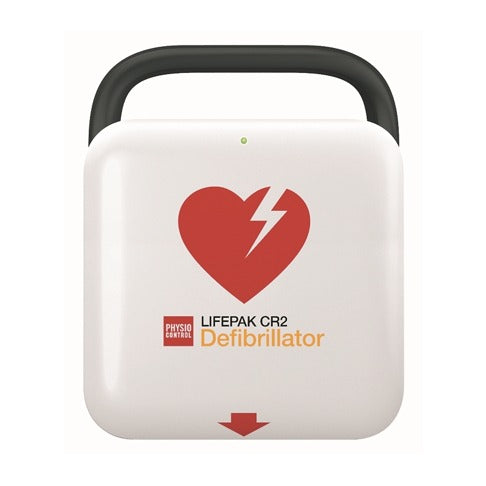AEDs are Literal Life Savers!
Automated External Defibrillators (AEDs) are life-saving devices that have become increasingly important in Canadian homes, workplaces, and public spaces. With sudden cardiac arrest (SCA) affecting thousands of Canadians each year, having immediate access to an AED can mean the difference between life and death. This comprehensive guide covers everything Canadian consumers and organizations need to know about AEDs, from selection and purchase to maintenance and training.
What is an AED and How Does it Work?
An Automated External Defibrillator (AED) is a portable electronic device designed to diagnose and treat sudden cardiac arrest through defibrillation. Defibrillation is the process of delivering an electric shock to restore normal heart rhythm when a person experiences life-threatening arrhythmias, particularly ventricular fibrillation.
Modern AEDs are remarkably user-friendly, designed for use by both medical professionals and untrained bystanders. The device provides audio and visual instructions to guide users through the rescue process:
- The AED machine analyzes the victim's heart rhythm
- It determines if a shock is necessary
- If needed, it delivers a controlled electric shock to restore normal heart rhythm
- It provides CPR coaching for the rescuer
Unlike the complex defibrillators seen in hospitals, public-access AEDs are specifically designed to be intuitive, with most models requiring just the press of a button to begin the automated process.

Why Every Canadian Should Consider an AED
Sudden cardiac arrest is a leading cause of death in Canada, with approximately 50,000 cardiac arrests occurring outside of hospitals annually. When SCA strikes, time is critical—for every minute that passes without defibrillation, survival rates decrease by 7-10%.
Consider these sobering statistics:
- Without immediate intervention, SCA survival rates are less than 5%
- When an AED Defib is used within the first 3-5 minutes, survival rates can increase to over 70%
- The average EMS response time in Canadian urban areas ranges from 8-12 minutes—often too long for SCA victims
With many cardiac arrests occurring at home (approximately 70%), having an AED readily available can dramatically improve outcomes for loved ones. Similarly, workplaces and public spaces with AEDs contribute significantly to community health safety.
Top AED Models Available in Canada
The Canadian market offers several high-quality AEDs suitable for different environments. Here are some of the most popular models:
ZOLL AED 3
- Enhanced Real CPR Help with full-color display
- WiFi connectivity for remote monitoring
- Universal adult/child CPR compression depth
- Touchscreen interface

https://aed.ca/products/zoll-aed-3
Physio-Control/Stryker AEDs
Physio-Control LIFEPAK CR2
- Bilingual capability (English/French) ideal for Canadian settings
- cprINSIGHT™ technology allows analysis during CPR
- LIFELINKcentral™ AED Program Manager for remote monitoring
- Highest available energy output (up to 360J)

https://aed.ca/products/stryker-physio-cr2-semi-auto-english-wifi
AED Pricing in Canada
The cost of AEDs in Canada typically ranges from $1,899 to $2,500 CAD for new units, depending on the model, features, and included accessories. Recertified units may be available starting around $999.
Additional costs to consider include:
- Replacement pads/electrodes ($50-$300, requiring replacement every 2-5 years)
- Replacement batteries ($200-$400, typically lasting 2-5 years)
- AED cabinets or wall mounts ($50-$300)
- AED signage ($15-$50)
Many AED suppliers offer package deals that include training, cabinets, and additional pads, which can provide better value than purchasing components separately.
AED Regulations and Requirements in Canada
While AEDs are not mandatory in all Canadian settings, several provinces have enacted legislation encouraging or requiring their placement in certain locations:
- Manitoba: The Defibrillator Public Access Act requires AEDs in designated public places
- British Columbia: WorkSafeBC recommends AEDs in workplaces with specific risk factors
AED Maintenance Requirements
Proper maintenance is crucial to ensure your AED functions correctly when needed:
-
Daily/Weekly Visual Checks:
- Verify the status indicator shows "ready" or "OK"
- Ensure the device is clean and undamaged
- Check that supplies are present and unexpired
-
Monthly Checks:
- Inspect pads for expiration dates
- Verify battery status
- Ensure all accessories are present and in good condition
-
Annual Maintenance:
- Professional inspection recommended
- Software updates if applicable
- Comprehensive functionality testing
-
Battery and Pad Replacement:
- Replace batteries according to manufacturer guidelines (typically every 2-5 years)
- Replace pads after use or expiration (typically every 2-5 years)
Many modern AEDs perform automatic self-tests and can alert owners to problems via indicator lights, beeping alarms, or even wireless notifications.
CPR and AED Training for Canadians
While most AEDs are designed to be used without training, proper education significantly improves confidence and effectiveness during an emergency. Several organizations offer certified CPR/AED training across Canada:
- Canadian Red Cross: Offers combined CPR and AED training courses across Canada
- Heart & Stroke Foundation: Provides various levels of CPR/AED training
- St. John Ambulance: Delivers workplace-focused first aid and AED courses
- Canadian Standards Association (CSA): Establishes training standards for AED use
Most courses can be completed in 4-6 hours and certification typically remains valid for 1-3 years. Many employers cover the cost of training for their staff.
AED Tax Benefits and Grants for Canadian Organizations
Canadian businesses and organizations may qualify for various financial benefits when purchasing AEDs:
- Capital Cost Allowance: AEDs qualify as medical equipment for tax deduction purposes
- Health and Safety Expense Deductions: Businesses can typically deduct AED costs as workplace safety expenses
- Provincial Grants: Some provinces offer grant programs for AED placement in community spaces
- Non-Profit Support: Organizations like Heart & Stroke Foundation occasionally provide AED placement programs for eligible groups
Consult your accountant about specific tax advantages for your situation, and check with provincial health authorities about current grant opportunities.
Public Access Defibrillation Programs in Canada
Public Access Defibrillation (PAD) programs aim to increase AED availability in communities across Canada. These initiatives include:
- AED Registry Programs: Provincial registries that connect with 911 dispatch to direct bystanders to nearby AEDs
- Heart Safe Communities: Municipal programs that encourage strategic AED placement
- PulsePoint: Mobile app that alerts CPR-trained citizens to nearby cardiac emergencies and AED locations
Getting involved with these programs can help create more heart-safe communities throughout Canada.
Legal Considerations: Good Samaritan Laws in Canada
Many Canadians hesitate to use AEDs due to liability concerns. However, all Canadian provinces and territories have enacted "Good Samaritan" legislation that protects individuals who provide emergency assistance, including AED use, from legal liability provided they:
- Act in good faith
- Are not grossly negligent
- Do not expect compensation
- Act within the scope of their training
These protections apply to both trained professionals and untrained bystanders who attempt to help during an emergency.
Choosing the Right AED for Your Canadian Home or Business
When selecting an AED for your home, workplace, or organization, consider these key factors:
- Environment: Choose models designed for your specific setting (indoor vs. outdoor, temperature extremes, potential exposure to dust or water)
- User Population: Consider who might operate the device (trained staff vs. general public)
- Maintenance Requirements: Some models require more frequent maintenance than others
- Language Options: In bilingual areas, consider AEDs with both English and French instructions
- Connectivity Features: Some models offer remote monitoring and automatic alert capabilities
- Pediatric Capabilities: If children are present, ensure the device accommodates pediatric patients
- Local Support: Choose suppliers who provide training, maintenance support, and fast pad/battery replacement
- Warranty: Compare warranty periods and what they cover
AED Storage and Accessibility
Proper AED storage and placement dramatically impacts survival outcomes:
- Visibility: AEDs should be clearly visible with proper signage
- Accessibility: Devices should be accessible 24/7 if possible
- Strategic Placement: Position AEDs to ensure a maximum 3-minute retrieval time from any location
- Protection: Use appropriate cabinets (alarmed, heated for outdoor locations, etc.)
- Registration: Register your AED with local EMS and AED registry programs
For businesses, common placement locations include near entrances, beside elevators, in cafeterias, and near high-risk areas like gyms or workshops.
The Future of AED Technology in Canada
AED technology continues to advance, with several promising developments on the horizon:
- Smaller, More Portable Devices: Personal-use AEDs the size of smartphones
- Enhanced Connectivity: Integration with emergency response systems and telehealth platforms
- Artificial Intelligence: AI-enhanced rhythm analysis and treatment recommendations
- Extended Battery Life: Next-generation batteries offering 10+ years of standby capability
- Wearable Defibrillators: For high-risk individuals awaiting permanent solutions
As technology improves, AEDs will likely become more affordable, further increasing accessibility across Canada.
Conclusion: Taking Action to Save Lives
Sudden cardiac arrest can happen to anyone, anywhere, at any time. By investing in an AED and proper training, Canadians can significantly improve survival chances for SCA victims in their homes, workplaces, and communities.
Whether you're a homeowner concerned about family safety, a business owner protecting employees and customers, or a community organization serving the public, an AED represents one of the most impactful safety investments you can make.
Don't wait for a tragedy to highlight the importance of AED access. Take action today to become part of the solution to one of Canada's leading causes of death. After all, the life you save with an AED might be that of someone you love.
This comprehensive guide is provided by AED.ca, Canada's leading provider of Automated External Defibrillators. For personalized advice on selecting the right AED for your needs, contact AED.ca today.






